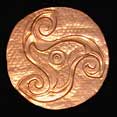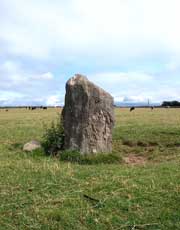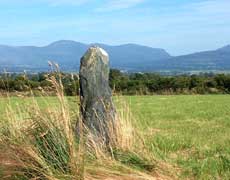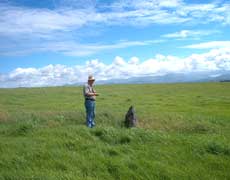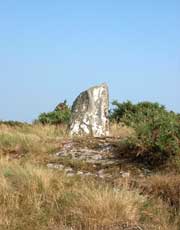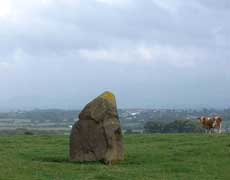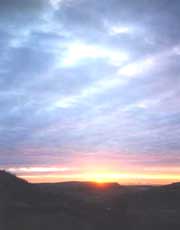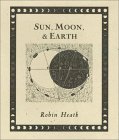|
…
Alban Arthan 2003
…
…
A Standing Stone At Maesoglan …
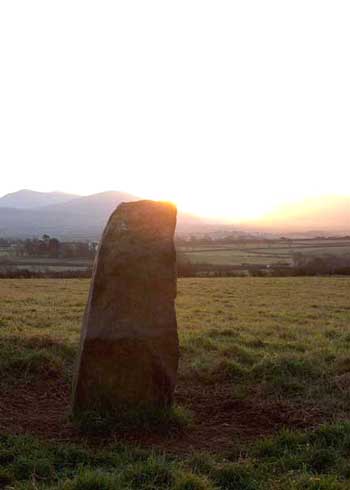
copyright © december 2003 morien institute
“MIDWINTER SUN AND STONE”
Midwinter sun, you are full of rock
And the men who are dark to us.
But as I wait, westerly in the webbed
Crisped field of frost and night shapes
Of cattle and standing stone, for the solstice
To declare itself in the angle of rock
And along the winter edge of the maenhir
Of Maesoglan – are you dark to me,
My brother, who set time here with your
Eyes and your keen mind for truth?
Are you dark to me now, my brother?
No more, now that I know how and why
You placed this stone precisely here –
In just this way for you – and for me.
I only know the shortest day because
Of your need – before there was the written
Lie – to fix the spinning of Earth
To the almightiness of the sun,
To the crescents of moons and a Pole Star
Stalking dragons in Arth Fawr for the tip
Of your outstretched finger in the green
Fields of your life and north to the sea.
Midwinter sun, you climb the bright
Sky behind Yr Wyddfa, flashing high
Thin scrawled clouds with daytime,
And I wonder why I have been drawn,
Middle-aged from my bed, to stand alone
Where I have never before been, knowing
That this stone rifles my sight across four
Millennia, and something that hurries the blood,
To the one sharp angle, tall and black
On the skylined back of Eryri.
Tell me, my small-boned brother, how
Do I have this conviction that our sun
Will rise like a bird of paradise
From the deep tangle of its winter nest
To stripe the sharp field with copper lustre,
Scribing there the steep toothed gap
Of Moel Eilio and Yr Aran?
When you set this stone, did you
Feel beyond your need for calendar
And of order for your crops and rites?
When you set this stone, did you
Imagine a world, beyond your sights,
Grown calloused old in mind and care?
When you set this maenhir in Maesoglan
And honed its sharp edge to the sky,
Did you think of me to come to Môn,
In the dark, to see the fire bird issue like
Paradise from the mountains of longing?
When I sighted along this stone,
I did greet more than the rising sun
Over the shoulder of a mountain –
For I saw you, prone at my feet,
With face to the living dawn
And as content as I was thrilled
To be together over time and tongue.
And I felt certain my words meant
Your words of haul for sun and
Effro for awakening, and maenhir
The long stone, and the longest
Stones standing on the shortest day –
Yr Wyddfa, Moel Eilio, Yr Aran.
And I knew of our life force spiralling
In your stone and light spinning
The sky and water divined underfoot;
And the gladness of it and meeting you
I heard come shouting from my throat
To stir the cattle in Maesoglan’s field.
It was Midwinter Day, AD 1977
And two thousand years to Bethlehem –
And a nova that called kings from afar
And the fire birds the shepherds from the hills.
T. Llewelyn Williams (1923 – eternity) …
On the eve of Alban Arthan, the Winter Solstice, December 20th each year, the druids of Morganwg observed the rising of the sun, and for that day only bestowed upon it the title/name of “Aran”. As the sun climbed to it’s lowest annual declination in the sky, they observed his annual slaughter by his brother, “Afagddu”, the personification of the “powers of darkness”.
Watching as the bleeding sun set (in the Rhondda over Gilfach Goch), they lamented the annual ‘death of the old year’, and for the next 40 hours awaited the resurrection and rebirth of the New Year in the rising of the new-born sun on December 22nd.
Throughout the day of December 21st, the Winter Solstice itself which they termed Alban Arthan, when the sun rises no higher, and sinks no lower, they regarded the ‘essence of the sun’ to be traversing the druidic underworld, ‘Annwn’, and engaged in empathetic rituals of initiation for the young candidates into the ‘mysteries of druidism’.
Then, at sunrise on December 22nd, as the sun began again it annual journey northwards to the instant of the Summer Solstice, which they termed Alban Hefyn, they celebrated the new-born sun, the son of the old sun – the “The Mabyn of the Mabynogion”.
As can be gleaned from the poem of T. Llewelyn Williams above, and as was witnessed by him in 1977, and again in 2003 along with R. Cecil Hughes and John Michael, the sun at the time of the shortest day rises over ‘Yr Aran’ when viewed from one particular standing stone at Maesoglan. This is no coincidence, and indicates without doubt that the ‘sacred landscapes’ of the druids of Ynys Môn (Anglesey) were as astronomically descriptive of the druidic solar drama as the ritual landscapes described by Morien in ancient Morganwg. And Maesoglan was just one of the many sacred places in North Wales where these observations were made, and ritual initiations undertaken.
Owen Morgan’s efforts at disentangling the ‘oral traditions’ of both Morganwg, and of Wales generally, have been ridiculed by orthodox historians who condemned him for his methodology in decoding the druidic library written in the landscape, and for his adoption of the druidic title, Morien, upon his succession as Archdruid of the Chair of Morganwg following the death of Myfyr Morganwg.
But these condemnations, which continue today, are invariably made by so-called ‘experts’ and ‘scholars’ who fail miserably to grasp the very simple concept of the ‘landscape as narrative’, who have never even attempted to read it, and who have never experienced the rising of the new-born sun at the sacred places of the ancient Welsh druids.
May their eyes be opened, before the the last vestiges of the Druidic Heritage of ancient Cymru (Wales) is lost forever amidst the rantings of those who can only condemn what they fail to understand …
Alban Hefyn (Summer Solstice) 2003
Bryn Celli Ddu, Ynys Môn, North Wales

copyright © June 21 2003
morien institute
|
